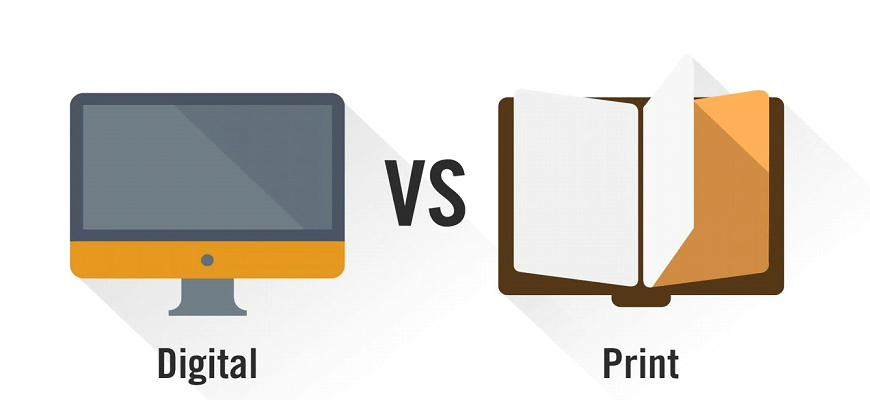Marketing is an important piece of practice success, but there are options when it comes to how you market your practice. The two main channels for marketing are print and digital, and you can choose as a practice to focus entirely on one channel, or utilize a combination of both. How do you know what’s right for your practice, though? Let’s take a look.
Print Marketing
Print marketing is executed using print media such as newspapers, magazines, telephone books, and even billboards. The cost for print marketing varies depending on the specific method employed. Newspaper ads can start around $1,000 for a full-page ad in the local newspaper of a smaller community and increase from there depending on the publication. Direct mail marketing, where a post card or some other printed media is sent to a specific mailing list, can start around $2,500 for a qualified list. Billboards in rural areas can start around $250 per month and increase in more populated areas. Yellow Pages ads start around $250 for a small ad, with prices increasing from there depending on the size of ad you want. It’s also important to remember that most of these costs include only running the advertising, so there will be additional expenses for ad design.
As with anything, there are a number of benefits and limitations to print media. Let’s look at the benefits first. To begin, there is a trustworthiness associated with print media that often translates to print advertising as well. This lends a credibility that can certainly benefit your practice as it gains awareness. Next, people typically remember print ads better than they do their digital counterparts. This is because there are generally fewer distractions when a reader is looking at something in print. This leads to stronger comprehension and, later, recall. Finally, print ads have the tendency to last longer, depending on the publication, because they’re attached to that content and so the ads last as long as the content retains value.
There are also, of course, limitations for print media. First of all, readership of print media is largely declining. It’s estimated that the all daily papers had a circulation decrease of around 14 million between 2005 and 2015, and the decrease has continued from there. Next, your audience is a little more limited with print media. This isn’t only due to the declining readership of print publications, but also the demographics of who is reading print publications. Typically print readers are older and more affluent, so by utilizing only print marketing you’re likely to miss potential patients of a lower socioeconomic status and those who are younger. Finally, print marketing isn’t as interactive as digital marketing for obvious reasons, so print ads are limited to providing information and unable to receive any feedback from the viewer.
Digital Marketing
Digital marketing is executed over the internet. This includes email marketing, social media marketing, website design, and more. It’s estimated that small to mid-sized businesses, which would include many medical practices, average between $2,500 and $12,000 each month for digital marketing. Obviously, this is a significant budget, depending on the revenue your practice brings in each month. Specifically, search engine optimization (SEO), an important piece of keeping your website in a prime location on search result pages, can start around $500 per month. Email marketing typically starts around $300 per month. Social media marketing can start at a minimum of $250 per month when outsourced, and website design often starts around $2,500.
Digital marketing has a number of benefits, among them a better value. Obviously, that sounds unlikely given the cost data we just reviewed, but it’s important to remember that a well planned digital marketing campaign can be targeted to meet the exact audience you’re looking for and will therefore have a higher value than certain print marketing methods. Second, digital marketing has the capability to provide measurable, trackable results. By using web analytics you can get detailed information about how your advertising was received and how effective it was. Finally, digital marketing has the capability of becoming social currency, meaning if your campaign is clever enough, there’s the possibility of it going viral and having a greater reach than you originally planned.
Digital marketing isn’t without its limitations, though. The first downside to digital marketing is that it can be time consuming to create an interactive and effective campaign. For this reason it’s especially important to keep an eye on your results so that you can be sure you’re getting a strong return on your investment. Additionally, digital marketing does tend to come with a higher initial cost. If your budget is more limited, this may prove prohibitive for your practice.
How to determine what’s best for your practice
Choosing a marketing strategy is not a one size fits all undertaking. You will need to consider your practice’s specific needs when deciding how to market most effectively. First, you’ll want to consider who you’re trying to reach with your marketing. Consider both your current patients and your ideal patients. Who are these people? Are they most likely to be spending their time reading print publications, or are they more likely to be spending their time online? Once you have the answers to these questions, that will help you to decide where to allocate your budget. That budget is the second thing you want to consider when deciding on your practice’s marketing strategy. Clearly different marketing tactics have different price tags, and you have to stick within the funds you have available. Decide on your practice’s specific strategy by considering what will provide the best value.
Marketing is important for a practice’s financial health and success, but there are many ways to effectively market a medical practice. The two main categories of marketing are print and digital. Each category has benefits and limitations, and what’s right for your practice depends on who you’re trying to reach and what you have available to spend. You don’t have to navigate all of this on your own, though, as there are resources available to help. One such resource is Practice Builders. Practice Builders focuses on social media, web design, reputation management, staff training, brand building, and electronic brochures and videos to provide a holistic marketing solution for your practice. The goal with Practice Builders is to attract new patients and increase the profitability of your practice. With Practice Builders, practice marketing isn’t seen as a one-size-fits-all solution. Practice Builders collaborates with each customer to create a marketing strategy that is unique to their practice and designed to bring success.
Another service that helps practices with marketing is PatientPop. PatientPop works to improve search engine results in order to help your practice reach more patients through web and social media channels. PatientPop’s platform is designed for growth, HIPAA-compliant, and delivers results that are clearly measurable. This is achieved through PatientPop’s engaging social media posts, informative blog content, and high-performing websites. Additionally, PatientPop establishes a continuous feedback loop with automated patient satisfaction surveys in order to proactively manage a medical practice’s online reputation.
Each of these services are a fantastic resource to help medical practices use marketing effectively to keep their business strong, and both Practice Builders and PatientPop are offered through Henry Schein Solutions Hub. Are you ready to take your practice marketing to the next level and see the difference it can make in your practice’s success? Visit henryscheinsolutionshub.com or call 833-433-2482 for more information on how to get started.




